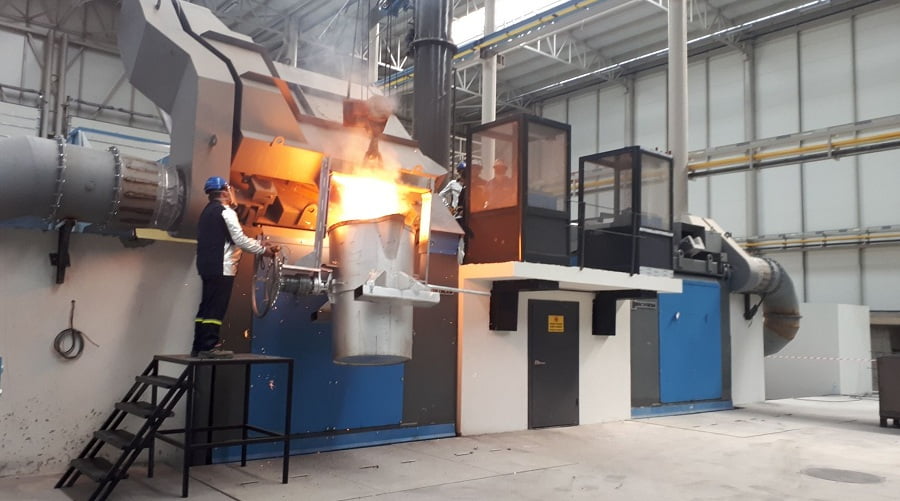Induction Furnace VS Blast Furnace
Both induction furnace and blast furnace are metallurgical equipment. What is the specific difference of induction furnace VS blast furnace?
Induction Furnace
At present, the most widely used induction melting furnaces in cast iron production are power frequency induction furnaces and intermediate frequency induction furnaces.
The power frequency induction furnace can melt and heat up the metal, and the heating is even and the burning loss is small, which is convenient for adjusting the composition of the molten iron and has little pollution.
However, the melting speed of the cold material in the power frequency induction furnace is slow, which is not conducive to slagging, and the starting block is required to start the cold furnace, and the production is not flexible enough, so it is generally used for remelting and heating of metals and alloys.
In addition, the power factor of the power frequency induction furnace is low, and many compensation capacitors need to be configured, which also increases the floor area and equipment investment.
The medium frequency induction furnace has high electrical and thermal efficiency, short smelting time, power saving, less floor space, lower investment, easy process automation, and production flexibility.
The medium frequency induction furnace is suitable for melting cast iron, especially for melting alloy cast iron, nodular cast iron, and vermicular graphite cast iron. It also has strong adaptability to the charge, and the variety and lumpiness of the charge can be changed within a wide range.
Although the intermediate frequency induction furnace has many advantages and develops rapidly, the power frequency induction furnace is still good equipment in terms of molten iron storage, heat preservation, adjustment of alloy composition, and overheating, especially as a blast furnace, cupola, etc. The dual-purpose furnace of melting furnace is still widely used.
The world’s most famous and largest manufacturer of centrifugal ductile iron pipes, France’s Musongqiao Company adopts a dual process of power frequency induction furnace and blast furnace, while Japan’s Kubota Company adopts a dual process of power frequency induction furnace and cupola.
As early as the early 1980s, Shougang Foundry first adopted the double-connection process of power frequency induction furnace and blast furnace or cupola in China, successfully trial-produced continuous casting cast ductile iron pipes, and provided high-temperature and high-quality molten iron for future production. It has been used until now with good results.
Blast Furnace
Blast furnace smelting is a continuous process of reducing iron ore to pig iron. Solid raw materials such as iron ore, coke, and flux are fed into the blast furnace in batches by the furnace top charging device according to the specified ratio, and the furnace throat material level is kept at a certain height.
Coke and ore form alternate layered structures in the furnace. The ore material is gradually reduced and melted into iron and slag during the descending process, which is gathered in the hearth and released from the iron and slag ports regularly.
Pig iron is a blast furnace product (referring to blast furnace smelting pig iron), and blast furnace products are not only pig iron, but also ferromanganese, etc., which are ferroalloy products. Ferromanganese blast furnaces do not participate in calculating various indicators of ironmaking blast furnaces.
The blast furnace ironmaking process also produces by-products such as slag, slag wool, and blast furnace gas.
The characteristics of blast furnace ironmaking: large scale, whether it is in other countries in the world or in China, the volume of blast furnaces is constantly expanding. For example, the blast furnace of Baosteel in my country is 4,063 cubic meters, with a daily iron production of more than 10,000 tons, slag of more than 4,000 tons, and daily coke consumption of more than 4,000 Tons.
The raw materials for blast furnace smelting are mainly composed of iron ore, fuel (coke), and flux (limestone).
Usually, smelting 1 ton of pig iron requires 1.5-2.0 tons of iron ore, 0.4-0.6 tons of coke, 0.2-0.4 tons of flux, and a total of 2-3 tons of raw materials are required. In order to ensure the continuity of blast furnace production, a sufficient supply of raw materials is required.
Therefore, whether it is pig iron manufacturers or steel mills, the work of purchasing raw materials is particularly important.
The above is the content about induction furnace VS blast furnace. They have their own advantages in their respective fields.

